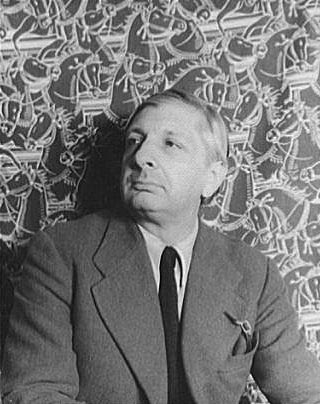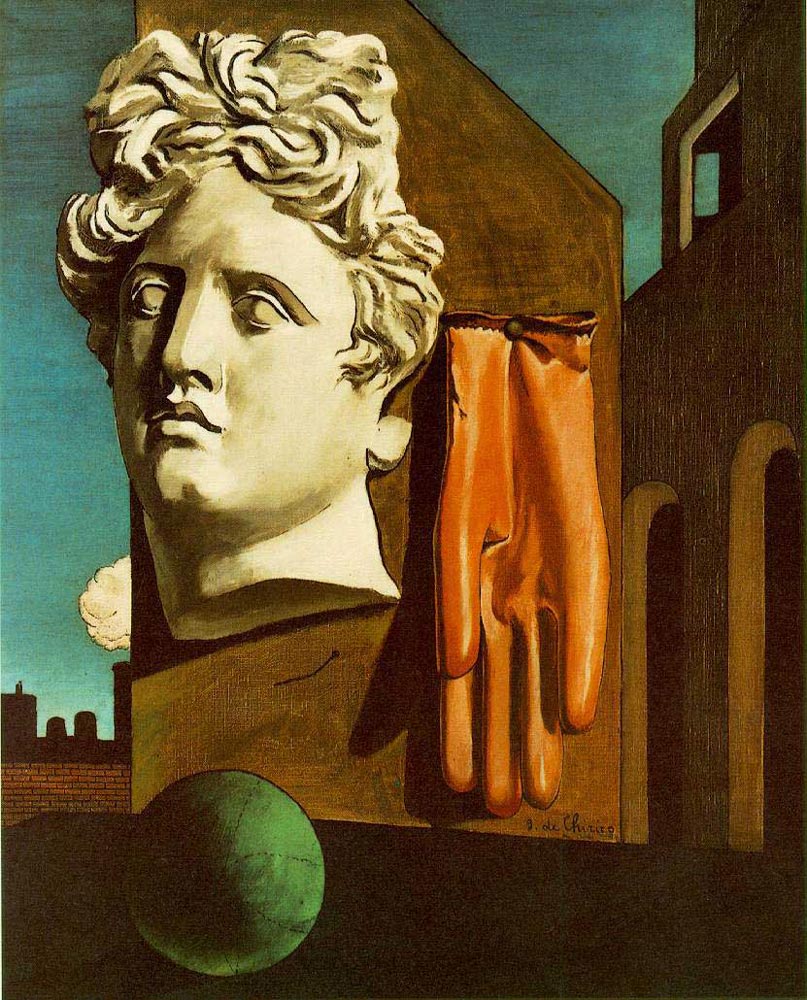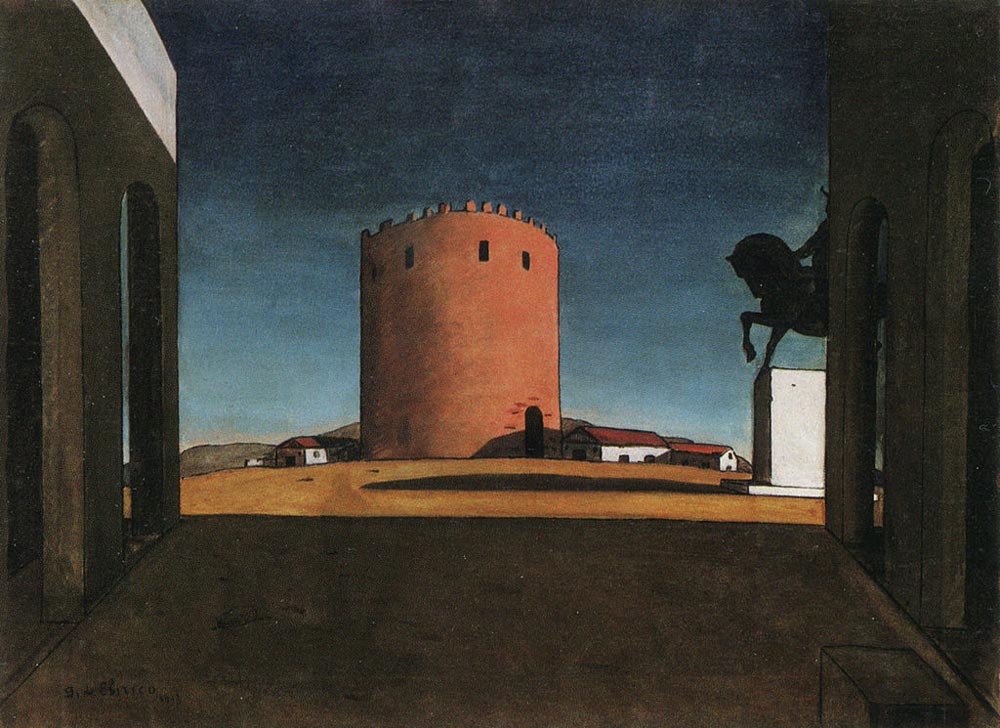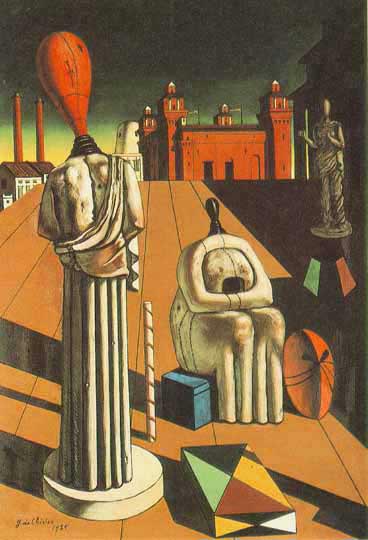| Giorgio de Chirico | |
|---|---|
 |
|
| Born | July 10, 1888 Volos, Greece |
| Died | November 20, 1978 (at age 90) Rome, Italy |
| Nationality | Italian |
| Education | Academy of Fine Arts in Munich |
| Movement | Scuola metafisica, Surrealism |
| Field | Painting, Sculpture, Drawing, Costume and Stage design |
| Works | View Complete Works |
Giorgio de Chirico (1888-1978) was an Italian artist who was known for his influence on the Surrealist movement. De Chirico himself is not usually considered part of that school, but part of his own movement of Metaphysical Ar. His early works were strongly metaphysical in nature, although later in his life, he made greater use of traditional techniques. Nevertheless, he continued to make references to his earlier style.
Personal Life
Although Italian by nationality with Italian parents, de Chirico was born in the Greek seaport of Volos. Much of his early artistic education took place in Athens, where he was taught by the renowned Greek artist, Georgios Roilos. He also spent some time studying in Florence, but a change took place on the death of his father in 1905. The following year, de Chirico went to live and study in Germany. He enrolled at Munich’s Academy of Fine Arts, where he became interested in philosophy. He read widely, covering the works of many philosophers including Friedrich Nietzsche, Max Klinger, and Arthur Schopenhauer.
 In 1909, de Chirico moved back to Italy, spending a few months in Milan before moving to Florence. In 1911, he moved to France to live with his brother, Andrea. When World War I broke out, de Chirico tried to enlist in the Italian armed forces, but was deemed as being unfit for duty and was sent to work in a hospital in Italy. He married for the first time to Raissa in 1925, but the marriage was short and stormy. In 1930, he met his second wife Isabella, a Russian like his first, and this marriage was much more stable. De Chirico and Isabella remained a couple until his death almost half a century later. The couple lived in Rome for the last three decades of de Chirico’s life.
In 1909, de Chirico moved back to Italy, spending a few months in Milan before moving to Florence. In 1911, he moved to France to live with his brother, Andrea. When World War I broke out, de Chirico tried to enlist in the Italian armed forces, but was deemed as being unfit for duty and was sent to work in a hospital in Italy. He married for the first time to Raissa in 1925, but the marriage was short and stormy. In 1930, he met his second wife Isabella, a Russian like his first, and this marriage was much more stable. De Chirico and Isabella remained a couple until his death almost half a century later. The couple lived in Rome for the last three decades of de Chirico’s life.
Artistic Development
De Chirico’s early works are usually considered his most significant. In the decade between 1909 and 1919, he produced a series of paintings in a style which is sometimes classified as his “metaphysical period.” This series was sparked by a feeling of revelation that de Chirico experienced in Florence’s Piazza Santa Croce. Turin also had a spiritual effect on the artist, despite the fact that he was there for only a few days in the summer of 1911. By now, de Chirico was sufficiently well known and well connected enough to be exhibiting a few of his paintings at the Salon d’Automne, where he also made his earliest sales. Artists of the caliber of Pablo Picasso, who were also at the Salon, commented favorably on de Chirico’s works.
 Although de Chirico’s artistic development was slowed by the outbreak of World War I, once the conflict was over in 1918, his work was again in great demand all over Europe. By this time, his subjects had moved from light-filled city scenes to interior studies. These often depicted untidy store-rooms, and sometimes included strange, mannequin-like figures. However, 1919 saw a larger change in his approach. After publishing an article titled “The Return of Craftsmanship” in an Italian magazine, de Chirico turned away from modern art, instead praising the classical style of Raphael and other old masters. De Chirico felt that his later, more traditional works were his best, but critics tended to prefer his metaphysical paintings.
Although de Chirico’s artistic development was slowed by the outbreak of World War I, once the conflict was over in 1918, his work was again in great demand all over Europe. By this time, his subjects had moved from light-filled city scenes to interior studies. These often depicted untidy store-rooms, and sometimes included strange, mannequin-like figures. However, 1919 saw a larger change in his approach. After publishing an article titled “The Return of Craftsmanship” in an Italian magazine, de Chirico turned away from modern art, instead praising the classical style of Raphael and other old masters. De Chirico felt that his later, more traditional works were his best, but critics tended to prefer his metaphysical paintings.
Notable Artworks
 Among the best known of de Chirico’s metaphysical paintings is The Nostalgia of the Infinite, which he completed in 1913. This shows a tall tower in Italy, shown in low evening sunlight. The artist produced several other paintings centered on towers, but this is the most famous of those. Two men, seen only as shadows, stand beneath the tower. Their appearance is similar to that of figures in later works by the Surrealist painter, Salvador Dali. De Chirico was impressed by the tower’s architecture and its impressive metaphysical presence, feeling a connection between Turin and Nietzsche, who de Chirico followed at that time.
Among the best known of de Chirico’s metaphysical paintings is The Nostalgia of the Infinite, which he completed in 1913. This shows a tall tower in Italy, shown in low evening sunlight. The artist produced several other paintings centered on towers, but this is the most famous of those. Two men, seen only as shadows, stand beneath the tower. Their appearance is similar to that of figures in later works by the Surrealist painter, Salvador Dali. De Chirico was impressed by the tower’s architecture and its impressive metaphysical presence, feeling a connection between Turin and Nietzsche, who de Chirico followed at that time.
De Chirico was intrigued by the classical figure of Ariadne, and included her in a series of seven paintings in the form of a statue. This series, which he began in 1912, uses color to underline the solitude of the deserted scenes de Chirico depicts. Dark shades are used throughout, whether for the sky or for the stone of the buildings, which emphasizes the anger of Ariadne when Theseus leaves her. De Chirico frequently made use of long, slender shadows in order to increase this sense of loneliness in the paintings. He returned to this theme of classical mythology a number of times over the course of the following years.